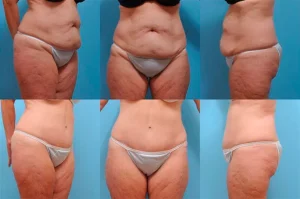Fat Transfer Breast Augmentation vs. Breast Implants: Choosing the Right Option for You
When considering breast augmentation, two popular options stand out: fat transfer breast augmentation and traditional breast implants. Both procedures aim to enhance breast size and shape, but they differ significantly in their approach, results, and suitability for different patients. Understanding the pros and cons of each method can help you make an informed decision about which procedure might be best for your individual needs and goals.
Fat Transfer Breast Augmentation
Fat transfer breast augmentation, also termed autologous fat grafting, is a cutting-edge technique that utilizes a patient’s own body fat to increase breast volume and improve shape. This method has recently surged in popularity, primarily due to two key factors. First, it produces remarkably natural-looking results, as the augmentation is achieved using the body’s own tissue. Second, it offers the additional advantage of body contouring, as the fat used for breast enhancement is harvested through liposuction from areas where the patient desires reduction, effectively providing a dual aesthetic benefit.
Procedure: The fat transfer process involves three main steps:
- Liposuction to harvest fat from areas such as the abdomen, thighs, or flanks
- Processing and purification of the harvested fat
- Careful injection of the purified fat into the breasts
Advantages:
- Natural look and feel: Since the procedure uses your fat, the results tend to look and feel very natural
- Dual benefit: Improves body contour in the area where fat is harvested
- No foreign objects: Reduces risks associated with implants, such as capsular contracture
- Minimal scarring: Only small incisions are required for liposuction and fat injection
- Long-lasting results: With proper technique, a significant portion of transferred fat can survive long-term
Limitations:
- The size increase is typically modest, usually up to one cup size
- Multiple sessions may be needed for the desired results
- Results can be affected by weight fluctuations
- Not all patients have enough excess fat for the procedure
- The body may reabsorb some of the transferred fat

Breast Implants
Breast implants have been the traditional method of breast augmentation In NJ for decades. They involve the surgical placement of silicone or saline implants to increase breast size and improve shape.
Procedure: The breast implant surgery typically involves:
- Making an incision (in the breast crease, around the areola, or in the armpit)
- Creating a pocket for the implant (either under the breast tissue or under the chest muscle)
- Inserting and positioning the implant
- Closing the incisions
Advantages:
- Significant and predictable size increase
- A wide range of sizes and shapes available
- Long-lasting results (though implants may need replacement after 10-15 years)
- Can address significant asymmetry
- Suitable for patients with minimal natural breast tissue
Limitations:
- Risk of complications such as capsular contracture, implant rupture, or displacement
- May require a replacement or removal in the future
- Can interfere with mammograms and breastfeeding
- It may not look or feel as natural as one’s tissue
- Visible scarring, depending on incision placement
Comparing the Two Procedures
Candidacy: Fat transfer is ideal for patients who desire less of an increase in breast size and have adequate excess fat in other areas of their body. It’s also a good option for those who want to avoid implants or are concerned about long-term implant-related issues.
Breast implants are suitable for a broader range of patients, including those who want a more significant size increase or have little natural breast tissue. They’re also a good option for patients with little excess fat or those desiring a particular shape or size.
Results: Fat transfer typically provides a more natural look and feel, as it uses the patient’s own tissue. The results can also improve over time as the transferred fat settles and integrates with existing breast tissue.
Implants offer more predictable and dramatic results, with a wider range of size options. However, they may look less natural, especially in very thin patients or those with little natural breast tissue.
Longevity: While some transferred fat may be reabsorbed in fat transfer procedures, the remaining fat can last indefinitely. However, results can be affected by weight fluctuations.
Breast implants typically last 10-15 years before replacement may be necessary. They’re not considered lifetime devices, and future surgeries should be anticipated.
Recovery: Fat transfer usually has a quicker recovery time, with most of the patients returning to normal activities within a week. There may be some bruising and swelling in both the donor and recipient sites.
Recovery from breast implant surgery can take 1-2 weeks, with restrictions on physical activities for several weeks. Patients may experience more discomfort and a longer healing process than fat transfer.
Scarring: Fat transfer results in minimal scarring, usually just small marks from the liposuction and injection sites.
Breast implant surgery leaves more noticeable scars, though their visibility depends on the incision placement and can improve over time.
Cost: The cost of these procedures can vary widely depending on geographic location, surgeon expertise, and specific techniques used. Fat transfer may generally be more expensive due to its complexity and the time involved. However, considering the potential long-term costs of implants, including possible replacement surgeries, is essential.
Making Your Decision
Choosing between fat transfer breast augmentation and breast implants is a highly personal decision that needs to be made after careful consideration of your goals, body type, and lifestyle. Factors to consider include:
- Desired increase in breast size
- Natural body fat availability
- Comfort with the idea of implants
- Long-term maintenance considerations
- Recovery time preferences
- Budget
Consultations with board-certified plastic surgeons are crucial in making this decision. They can assess your case, discuss your goals, and recommend the best approach for your unique situation.
For expert guidance on breast augmentation options and to discuss which procedure might be proper for you, contact The Plastic Surgery Group in Montclair, NJ. Their experienced team of board-certified plastic surgeons can provide personalized advice and help you achieve your aesthetic goals safely and effectively.
For those interested in less invasive cosmetic services, The Plastic Surgery Group’s partner, Arria MedSpa, also located in Montclair, offers a range of non-surgical treatments to enhance your look in addition to boosting your confidence. From skin rejuvenation to body contouring, Arria MedSpa provides cutting-edge aesthetic services in a luxurious, spa-like setting.
Whether you’re considering a transformative breast augmentation or looking for subtle enhancements, The Plastic Surgery Group and Arria MedSpa in Montclair, NJ, are equipped to meet your needs with the utmost highest standards of care and expertise.




